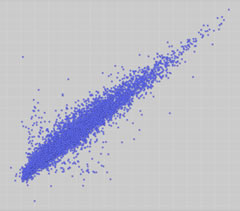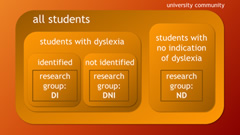
discourse study-blog | resources | lit review maps | profiles
enquiry research QNR | dysdefs QNR | dysdims QNR
 enquiry & analysis
enquiry & analysis Collecting and working with data
Collecting and working with data
This section is home to the data and analysis part of the project.
As data has been collected and examined, overviews of the results and analyses can be found below where links to more in-depth commentary and discussion are provided.
Throughout the development stages of the project, smaller-scale data enquiries emerged out of a need to explore underpinning aspects of the research more fully. In particular, those conducted to date greatly aided the development of the main research questionnaire and may warrant more individual write-ups in advance of submission for publication. Overview reports on these preliminary enquiries are also presented below.
Given that the main data collection process is now complete (Summer 2016), the final section of this page presents an overview of the results so far. As the data is examined in more detail, this overview will be updated accordingly and include signposts to more extensive writings which are/will be hosted on the project's StudyBlog pages.
QuickLinks to these items are provided below:At the bottom are links to data analysis tools and resources to support this part of the project.
Preliminary Enquiry I: Definitions of Dyslexia
 Dyslexia is a syndrome and it is becoming clear that there are many definitions of dyslexia in current usage across professional domains, in places of learning, amongst parents and teachers and by individuals with dyslexia. These appear to have grown from whichever perspective on dyslexia has held the centre ground at the time and have been in keeping with an element of transition from viewing dyslexia from a medical standpoint to it being more widely accepted now as in keeping with a social model of disability. A Working Party Report by the British Psychological Society (1999) suggested several hypotheses related to dyslexia before eventually settling on a definition (Reid, 2003), and many earlier researchers defer back to the 1968, World Federation of Neurology definition (Critchley & Critchley, 1978). However one of the most interesting facets to the discussion uncovered so far dates from one of the earliest original 'diagnoses' of word-blindness presented in a paper by Hinshelwood (1896). It is interesting because aside from identifying a patient's difficulty with printed text, Hinshelwood also describes additional challenges faced by this individual in his capacity as a tradesman relating to working systematically and encountering memory difficulties, two of many characteristics associated with dyslexia in the Higher Education sector which are aside from 'word-blindness' difficulties with reading and accessing text-based learning materials.
Dyslexia is a syndrome and it is becoming clear that there are many definitions of dyslexia in current usage across professional domains, in places of learning, amongst parents and teachers and by individuals with dyslexia. These appear to have grown from whichever perspective on dyslexia has held the centre ground at the time and have been in keeping with an element of transition from viewing dyslexia from a medical standpoint to it being more widely accepted now as in keeping with a social model of disability. A Working Party Report by the British Psychological Society (1999) suggested several hypotheses related to dyslexia before eventually settling on a definition (Reid, 2003), and many earlier researchers defer back to the 1968, World Federation of Neurology definition (Critchley & Critchley, 1978). However one of the most interesting facets to the discussion uncovered so far dates from one of the earliest original 'diagnoses' of word-blindness presented in a paper by Hinshelwood (1896). It is interesting because aside from identifying a patient's difficulty with printed text, Hinshelwood also describes additional challenges faced by this individual in his capacity as a tradesman relating to working systematically and encountering memory difficulties, two of many characteristics associated with dyslexia in the Higher Education sector which are aside from 'word-blindness' difficulties with reading and accessing text-based learning materials.
So attempting arrive at a consistent, valid and appropriate working definition for dyslexia has clearly proved problematic throughout the last century and discussing the journey that the definition of dyslexia has made throughout this time will form part of this project's literature review. To aid in the systematic collecting of ideas and resources to support this section of the final write-up, a Literature Review Map is in progress, being published and continuously updated here![]() which eventually will form a time-line observation of the development of both understanding and misunderstanding of the syndrome.
which eventually will form a time-line observation of the development of both understanding and misunderstanding of the syndrome.
 So although pinning down a definition of dyslexia is challenging it is felt that tackling this is important in order that the project can be built on a theoretically robust foundation. Existing literature in the field demonstrates that is it 'de rigeur' for researchers to attempt to define dyslexia in the preamble to their research report or academic paper. This seems a sensible and thorough part of 'the academic process' because a study should be underpinned by the theoretical framework within which it sits. Given this, it follows that the result and conclusion of a piece of research, that is, the academic output of the study will then be a function of the definition that enshrines its fundamental academic focus. However, in a field of research where there is a lack of consensus on fundamental definitions, it might be that a research agenda will be built on a definition that is selected out of many alternatives and that the academic output of that research will be a function of the definition selected; were a different definition used instead, the academic output is also likely to be different even if the research processes, and possibly the results, were the same or highly similar. So it further follows that a researcher might choose the most 'convenient' definition of a fundamental idea or principle in such a way that will best suit their research expectations - that is, their anticipated academic output. Whether this may occur with intent or not, this researcher is left feeling uneasy when reflecting on this dilemma.
So although pinning down a definition of dyslexia is challenging it is felt that tackling this is important in order that the project can be built on a theoretically robust foundation. Existing literature in the field demonstrates that is it 'de rigeur' for researchers to attempt to define dyslexia in the preamble to their research report or academic paper. This seems a sensible and thorough part of 'the academic process' because a study should be underpinned by the theoretical framework within which it sits. Given this, it follows that the result and conclusion of a piece of research, that is, the academic output of the study will then be a function of the definition that enshrines its fundamental academic focus. However, in a field of research where there is a lack of consensus on fundamental definitions, it might be that a research agenda will be built on a definition that is selected out of many alternatives and that the academic output of that research will be a function of the definition selected; were a different definition used instead, the academic output is also likely to be different even if the research processes, and possibly the results, were the same or highly similar. So it further follows that a researcher might choose the most 'convenient' definition of a fundamental idea or principle in such a way that will best suit their research expectations - that is, their anticipated academic output. Whether this may occur with intent or not, this researcher is left feeling uneasy when reflecting on this dilemma.
To this end, if this project is to be built on the current most 'in vogue' definition of dyslexia, gaining a better sense of how current or fashionable this definition may be will add confidence that the academic output of this project will be a function of a properly defined variable. Aside from working systematically through the literature to work this out, it seems that an equally good way to tackle the issue would be to try to tease out a contemporary view of a Definition of Dyslexia from the professional and academic communities that engage with it. That is, try to find out if there is broad agreement about what dysleixa is, or whether pinning it down remains as elusive and contradictory as ever.
So a brief eQNR was developed that offered 10 different definitions of dyslexia drawn from a variety of sources and which have been commonly used to underpin research or inform practitioners. The definitions were presented in the questionnaire in a random order and respondents were asked to select definitions that were most, to least aligned with their academic viewpoint and/or working, professional interpretation of the meaning of dyslexia, and then rank definitions chosen in order of 'most preferred' to 'least preferred'. The eQNR was distributed across the professional, academic and community-of-interest subscribers to the JISCMAIL Dyslexia List. 26 returns were received. The eQNR itself, together with a summary of the results, is available here or through the site navigation at the top of the page. A more informative discussion report posted on the project's StudyBlog. The results were interesting and will be making a useful contribution to the project.
Preliminary Enquiry II: Dimensions of Dyslexia
 The research design for this project scopes out the methodology for collecting data as a two-stage process. The first stage proposes to collect data from two distinct student sub-populations of the main student community: those with identified dyslexia (research group DI) and those with no indications of dyslexia (research group ND). The data will be examined to identify differences in the Locus of Control Profiles of students in each of the two groups so that the profiler can be developed into a discriminator that will identify characteristics of the dyslexic syndrome that are present in the study and learning attributes of individuals. Given that this is successful the plan is for it to be used to establish a third sample from the background population of students which will be those learners whose LoC profiles are aligned with the dyslexic group but who have previously had no indication, identification or 'diagnosis' of dyslexia (research group DNI). The research design then proposes that the academic agency of learners in each group can then be explored using the determiners of academic (behavioural) confidence and academic self-efficacy to look for significant differences. From the data collected from all of these processes, the primary research objective of the project can then be addressed, the gist of which is finding out whether the dyslexic label is more of an impacting factor on academic agency than the dyslexia is.
The research design for this project scopes out the methodology for collecting data as a two-stage process. The first stage proposes to collect data from two distinct student sub-populations of the main student community: those with identified dyslexia (research group DI) and those with no indications of dyslexia (research group ND). The data will be examined to identify differences in the Locus of Control Profiles of students in each of the two groups so that the profiler can be developed into a discriminator that will identify characteristics of the dyslexic syndrome that are present in the study and learning attributes of individuals. Given that this is successful the plan is for it to be used to establish a third sample from the background population of students which will be those learners whose LoC profiles are aligned with the dyslexic group but who have previously had no indication, identification or 'diagnosis' of dyslexia (research group DNI). The research design then proposes that the academic agency of learners in each group can then be explored using the determiners of academic (behavioural) confidence and academic self-efficacy to look for significant differences. From the data collected from all of these processes, the primary research objective of the project can then be addressed, the gist of which is finding out whether the dyslexic label is more of an impacting factor on academic agency than the dyslexia is.
However, through the reflective process that has been part of the first year of the project combined with the research focus shifting to the development of the main research QNR, there remains an element of uncertainty that the LoC profiler will fulfil its designed research purpose: that is, as a discriminator between learners with and without a dyslexic learning difference. It is recognized that properly developing this idea is more-than-likely a project in its own right and so given that the design of the project is exploring the academic agency of students with known dyslexia in comparison to the academic agency of students with possibly unknown dyslexia, it is felt that incorporating a second-string approach to discriminating for learning profiles that tend to be aligned with dyslexic ones, or not, may be prudent. Having said that, it has always been a development possibility that the LoC Profiler may show promise for developing into a new tool for discriminating dyslexia as a learning difference at a later stage or as subsequent project although it was also felt that it would be important not to let the research QNR become this screening tool because the core idea of the research is exploring the relationship of the dyslexia label to academic agency rather than dyslexia to academic agency.
The result of this period of reflection and development is a pragmatic acceptance that a more expedient research method will be to build a single research questionnaire and deploy it just once to all research groups simultaneously. The original design of the questionnaire will also be extended to include a section that asks students about their study and learning habits by relating to statements that are aligned, but not equal to similar items that may be found on Adult Dyslexia Screening Checklists which will cover the eventuality that the LoC Profiler does not meet the design expectations as a disciminator.
 However in building this new section of the QNR, it was felt that although Adult Dyslexia Screening Checklists are readily available none have been found so far that are specifically pitched at learners in Higher Education where it has been shown across the research literature that dyslexia often impacts on academic processes in ways that are not specifically pre-identified in screening tools not the least due to students being able to mask their challenges (eg: Casale, 2015). As such, and together with the researcher's own experiences supporting the learning development of students with dyslexia at university, it was felt that although the existing Adult Dyslexia Checklists might be used for guidance, gaining a better sense of the typical characteristics presented by students with dyslexia at university could enable this section of the QNR to be developed to have a more relevant focus and hence strengthen its validity and reliability.
However in building this new section of the QNR, it was felt that although Adult Dyslexia Screening Checklists are readily available none have been found so far that are specifically pitched at learners in Higher Education where it has been shown across the research literature that dyslexia often impacts on academic processes in ways that are not specifically pre-identified in screening tools not the least due to students being able to mask their challenges (eg: Casale, 2015). As such, and together with the researcher's own experiences supporting the learning development of students with dyslexia at university, it was felt that although the existing Adult Dyslexia Checklists might be used for guidance, gaining a better sense of the typical characteristics presented by students with dyslexia at university could enable this section of the QNR to be developed to have a more relevant focus and hence strengthen its validity and reliability.
So a second, small-scale enquiry has been developed and deployed to colleagues working in HE settings whose professional roles are focused on interacting with their respective universities' dyslexic student community. The eQNR sets out 18 chracteristics or attributes that each relate to how students with dyslexia tackle their studies and are referred to in the pre-amble as 'dimensions'. Each of the 18 dimensions is taken partly from the researcher's own experiences in working with students with dyslexia in university settings. But also more generally from the widespread body of literature that variously refers, in some part or another, to determining identiers that point towards dyslexia as a learning difference, both in terms of the creative strengths of dyslexic learners at university and of their deficits and weaknesses when their study challenges are contextualized against the study processes of non-dyslexic students. Particularly useful has been the literature review of developmental dyslexia in adults by Rice & Brooks (2004), specifically the comparison of checklist items observed in 8 widely used screening checklists provided in Appendix 5 of that document.
 The eQNR was deployed to 122 of the 132 UK Higher Education Institutions listed as members of Universities UK, being sent out through an e-mail directed to the most appropriate student service or department as identified by searching through universities' webpages. To date (October 2015) 30 replies were received. The task set out in the QNR preamble asked participants to consider the 18 dimensions of dyslexia listed and for each one, make a judgment about the frequency or prevalence that each dimension is encountered in their interactions with students with dyslexia. To do this, each dimension is listed as a 'stem' statement that provides a response to the opening question at the head of the QNR: 'In your interactions with students with dyslexia, to what extent do you encounter each of these dimensions?' The judgment is made by moving slider from its parked position half-way along a range line of 0 - 100% and participants are provided with a guide reminding them that 0% would indicate that they never come across that dimension (or have no information upon which to make a judgment) whereas setting a value of 100% would indicate that they encounter that dimension all the time when working with students with dyslexia.
The eQNR was deployed to 122 of the 132 UK Higher Education Institutions listed as members of Universities UK, being sent out through an e-mail directed to the most appropriate student service or department as identified by searching through universities' webpages. To date (October 2015) 30 replies were received. The task set out in the QNR preamble asked participants to consider the 18 dimensions of dyslexia listed and for each one, make a judgment about the frequency or prevalence that each dimension is encountered in their interactions with students with dyslexia. To do this, each dimension is listed as a 'stem' statement that provides a response to the opening question at the head of the QNR: 'In your interactions with students with dyslexia, to what extent do you encounter each of these dimensions?' The judgment is made by moving slider from its parked position half-way along a range line of 0 - 100% and participants are provided with a guide reminding them that 0% would indicate that they never come across that dimension (or have no information upon which to make a judgment) whereas setting a value of 100% would indicate that they encounter that dimension all the time when working with students with dyslexia.
As an aside, this eQNR provided an opportunity to trial this data-collecting process, that is, the HTML5 slider input function, which is essentially providing continuous scale Likert response items. There is much debate and controversy relating to categories used in Likert response items, not the least because fixed categories generate data points that must be arbitrarily coded to enable parametric statistical analysis to be applied to the results. A review of the discussion in the literature will be posted on the project's StudyBlog in due course.
View the eQNR through the page navigation at the top, together with a preliminary presentation of results, which includes an innovative 'radar plot' display of the dimensions and a correlation table that explores linkages between all pairs of dimensions, additionally displaying scatter plots.
Research Project Main Enquiry: Exploring dyslexia and academic agency
During the academic year 2015-16 a working draft of the main research QNR was developed and extensively tested to ensure that the innovative HTML5 technology incorporated into the eQNR design was functioning correctly and was as accessible as possible. Despite full Ethics Approval delays in gaining even 'gatekeeper' access to student lists has delayed the deployment of the eQNR until the summer term of the academic year 2015-16.
At the time of writing (September 2016) the data collection process is now complete with 166 'good' datasets received. Results have been transferred and collated into a master Excel spreadsheet and duplicated into SPSS for analysis.
Early-stage indicators show that the data is robust and highly interesting, with preliminary analysis indicating both a statistically significant difference and a reasonable effect size between the academic agency of students with identified dyslexia and those with a non-identified dyslexic profile as determined by the project's innovative Dyslexia Index metric and academic agency being characterized through Sander & Sanders' (2003) Academic Behavioural Confidence (ABC) Scale.
The Project Main Enquiry eQNR has been tested for the internal consistency reliability
of the 8 scales it sought to measure using Cronbach's Alpha (α) which includes a more extensive interpretation of the results that includes confidence interval estimates for α as recommended by Onwuegbuzie & Daniel (2000) amongst others. The summary results are published on the project's StudyBlog pages.
An overview of this preliminary analysis is available on the 'data summary' page accessible from the main navigation menu above. As the analysis process progresses during this year 2016-17 this will be updated accordingly.



